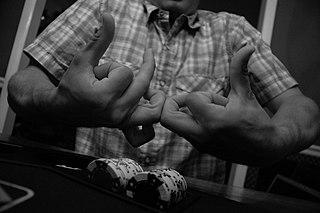
The Bloods are a primarily African-American street gang which was founded in Los Angeles, California. The gang is widely known for its rivalry with the Crips. It is identified by the red color worn by its members and by particular gang symbols, including distinctive hand signs.

The New York City draft riots, sometimes referred to as the Manhattan draft riots and known at the time as Draft Week, were violent disturbances in Lower Manhattan, widely regarded as the culmination of working-class discontent with new laws passed by Congress that year to draft men to fight in the ongoing American Civil War. The riots remain the largest civil urban disturbance in American history. According to Toby Joyce, the riot represented a "civil war" within the city's Irish community, in that "mostly Irish American rioters confronted police, [while] soldiers, and pro-war politicians ... were also to a considerable extent from the local Irish immigrant community."

The city of Philadelphia was founded and incorporated in 1682 by William Penn in the English Crown Province of Pennsylvania between the Delaware and Schuylkill rivers. Before then, the area was inhabited by the Lenape people. Philadelphia quickly grew into an important colonial city and during the American Revolution was the site of the First and Second Continental Congresses. After the Revolution the city was chosen to be the temporary capital of the United States. At the beginning of the 19th century, the federal and state governments left Philadelphia, but the city remained the cultural and financial center of the country. Philadelphia became one of the first U.S. industrial centers and the city contained a variety of industries, the largest being textiles.
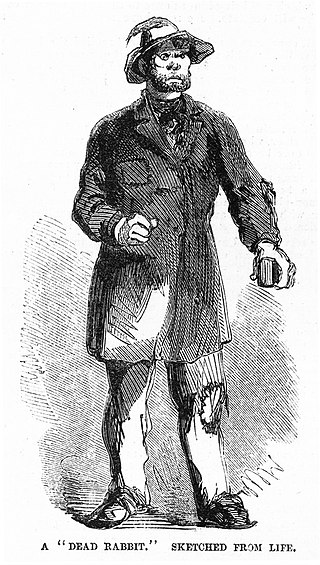
The Dead Rabbits was the name of an Irish American criminal street gang active in Lower Manhattan in the 1830s to 1850s. The Dead Rabbits were so named after a dead rabbit was thrown into the center of the room during a gang meeting, prompting some members to treat this as an omen, withdraw, and form an independent gang. Their battle symbol was a dead rabbit on a pike. They often clashed with Nativist political groups who viewed Irish Catholics as a threatening and criminal subculture. The Dead Rabbits were given the nicknames of "Mulberry Boys" and the "Mulberry Street Boys" by the New York City Police Department because they were known to have operated along Mulberry Street in the Five Points.
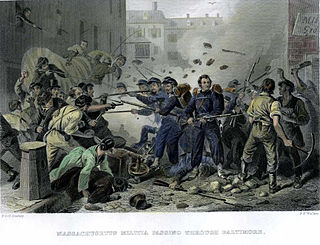
The Baltimore riot of 1861 was a civil conflict on Friday, April 19, 1861, on Pratt Street, Baltimore, Maryland. It occurred between antiwar "Copperhead" Democrats and other Confederate sympathizers on one side, and on the other, members of Massachusetts and Pennsylvania state militia regiments en route to the national capital at Washington who had been called up for federal service. The fighting began at the President Street Station, spreading throughout President Street and subsequently to Howard Street, where it ended at the Camden Street Station. The riot produced the first deaths of Union volunteers by hostile action, although caused by civilians, in the American Civil War. Civilians among the attackers also were killed.

The Plug Uglies were an American Nativist criminal street gang, sometimes referred to loosely as a political club, that operated in the west side of Baltimore, Maryland, from 1854 to 1865. The term plug ugly was used to identify an extremely tough ferocious fighter who could give a sound beating to an opponent, with the Plug Uglies' name additionally stemming from their practice of stuffing oversized plug hats with wool and leather, pulling them down over their ears for head protection as primitive helmets during the numerous street battles they participated in. The name Plug Uglies was used to refer to a number of criminal gangs in New York City as well as Philadelphia.
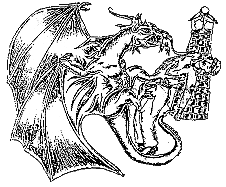
The Black Guerrilla Family is an African American black power prison gang, street gang, and political organization founded in 1966 by George Jackson, George "Big Jake" Lewis, and W.L. Nolen while they were incarcerated at San Quentin State Prison in Marin County, California.
Defenders Day is a longtime legal holiday on September 12, in the U.S. state of Maryland, in the City of Baltimore and surrounding Baltimore County. It commemorates the successful defense of the city of Baltimore on September 12-13-14, 1814 from an invading British force during the War of 1812, an event which led to the writing of the words of a poem, which when set to music a few days later, became known as "The Star-Spangled Banner", which in 1931 was designated as the national anthem of the United States.

John Patrick Looney (1865–1942) was an American political fixer and Irish mob boss based in Rock Island, Illinois during the early 20th century. At the height of his power, Looney controlled most of the illegal gambling, prostitution, bootlegging, and racketeering in Rock Island. Through his tabloid newspaper Rock Island News, he was able to blackmail and intimidate his opponents.
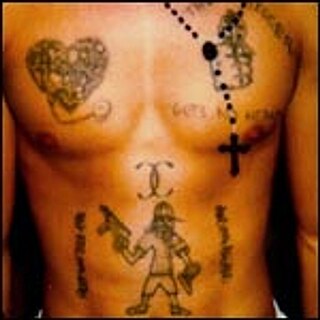
The Crips are a primarily African-American alliance of street gangs that are based in the coastal regions of Southern California. Founded in Los Angeles, California, in 1969, mainly by Raymond Washington and Stanley Williams, the Crips began as an alliance between two autonomous gangs, and developed into a loosely connected network of individual "sets", often engaged in open warfare with one another. Its members have traditionally worn blue clothing since around 1973.

The Great Railroad Strike of 1877, sometimes referred to as the Great Upheaval, began on July 14 in Martinsburg, West Virginia, after the Baltimore and Ohio Railroad (B&O) cut wages for the third time in a year. The Great Railroad Strike of 1877 was the first strike that spread across multiple states in the U.S. The strike finally ended 52 days later, after it was put down by unofficial militias, the National Guard, and federal troops. Because of economic problems and pressure on wages by the railroads, workers in numerous other states, from New York, Pennsylvania and Maryland, into Illinois and Missouri, also went out on strike. An estimated 100 people were killed in the unrest across the country. In Martinsburg, Pittsburgh, Philadelphia and other cities, workers burned down and destroyed both physical facilities and the rolling stock of the railroads—engines and railroad cars. Some locals feared that workers were rising in revolution, similar to the Paris Commune of 1871, while others joined their efforts against the railroads.
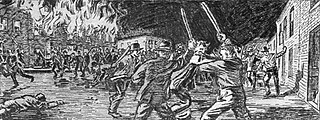
Bloody Monday was a series of riots on August 6, 1855, in Louisville, Kentucky, an election day, when Protestant mobs attacked Irish and German Catholic neighborhoods. These riots grew out of the bitter rivalry between the Democrats and the Nativist Know-Nothing Party. Multiple street fights raged, leaving twenty-two people dead, scores injured, and much property destroyed by fire. Five people were later indicted, but none were convicted, and the victims were not compensated.
Riots often occur in reaction to a perceived grievance or out of dissent. Riots may be the outcome of a sporting event, although many riots have occurred due to poor working or living conditions, government oppression, conflicts between races or religions.
Crime in Omaha, Nebraska has varied widely, ranging from Omaha's early years as a frontier town with typically widespread gambling and prostitution, to civic expectation of higher standards as the city grew, and contemporary concerns about violent crimes related to gangs and dysfunctions of persistent unemployment, poverty and lack of education among some residents.

George Proctor Kane was an American politician and policeman. He is best known for his role as Marshal of Police during the Baltimore riot of 1861 and his subsequent imprisonment at Fort McHenry and Fort Warren without the benefit of habeas corpus. His position as Marshal of Police and his southern sympathies were two of many factors in Abraham Lincoln's decision in February 1861 to pass through Baltimore surreptitiously on his way to Washington to be inaugurated, in order to avoid a possible assassination attempt. Despite his politics, Kane was instrumental in providing protection and an escort for Mary Todd Lincoln on her arrival in Baltimore in February 1861 on her way to the inauguration of her husband, who had preceded her.

This article describes the history of the Baltimore and its surrounding area in central Maryland since the establishment of settlements by European colonists in 1661.

People of Irish descent form the largest ethnic group in the city of Philadelphia and its surrounding counties. The Irish have lived in Philadelphia since the pre-American Revolution period. Irishmen had participated in pro-Revolutionary activities in Philadelphia during the Revolutionary War. Like many American cities in the 19th century, Philadelphia, which was once a Quaker stronghold, changed dramatically with the influx of European immigrants. The first major influx of Irish came in 1844 from rural areas, spurred by the Irish Famine. Because of the Quaker belief and pledge of religious tolerance, Irish Catholics and Protestants, among others, made the city incredibly diverse. Philadelphia at the time had a need for industrial labor, and at the time Philadelphia was becoming a major industrial center in the United States. Irish took industrial positions. In the 1840s and 1850s, anti-Catholic sentiment grew against the Irish, and eventually led up to riots, such as the Philadelphia nativist riots and the Lombard Street riot. Eventually the Irish gained financial and social status in the latter half of the 19th century and founded institutions during the period. Many Irish Philadelphians would later move on to other major Americans cities, such as Detroit, Milwaukee, Seattle, and St. Louis.

On April 12, 2015, Baltimore Police Department officers arrested Freddie Gray, a 25-year-old African American resident of Baltimore, Maryland. Gray's neck and spine were injured while he was in a police vehicle and he went into a coma. On April 18, there were protests in front of the Western district police station. Gray died on April 19.

The term Know-Nothing Riot has been used to refer to a number of political uprisings of the Know Nothing Party in the United States of the mid-19th century. These anti-immigrant and anti-Catholic protests culminated into riots in Philadelphia in 1844; St. Louis in 1854, Cincinnati and Louisville in 1855; Baltimore in 1856; Washington, D.C., and New York City in 1857; and New Orleans in 1858.

The Baltimore Know-Nothing riots of 1856 occurred in Baltimore, Maryland between September and November of that year. The Know Nothing Party gained traction in Baltimore as native-born residents disliked the growing immigrant population. Local street gangs became divided on political grounds, with the Know-Nothing affiliated gangs clashing with gangs affiliated with the Democratic Party. The partisans were involved in widespread violence at the polls and across Baltimore during municipal and national elections that year.

















